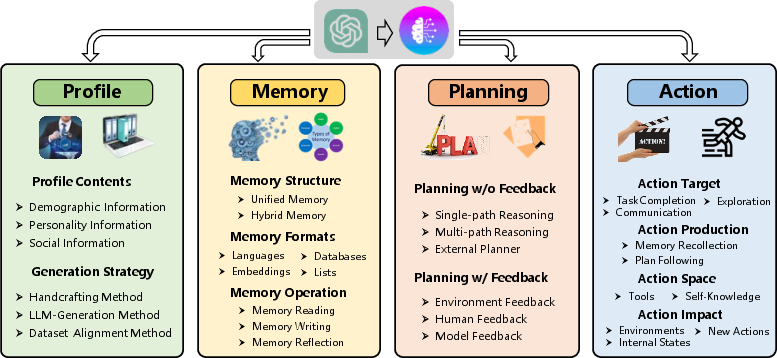- The paper provides a comprehensive review of LLM-based autonomous agents, focusing on architecture design, applications, and evaluation methods.
- Methodologies include the integration of profiling, memory management, planning, and action modules to effectively structure and perform tasks.
- The study evaluates agents using both subjective and objective metrics while addressing challenges such as role-playing accuracy, human alignment, prompt robustness, and hallucination.
"A Survey on LLM based Autonomous Agents" (2308.11432)
In recent years, the field of artificial intelligence has seen a significant shift towards leveraging LLMs to develop autonomous agents that aim to mimic human-level intelligence. The paper "A Survey on LLM based Autonomous Agents" provides a thorough review of the LLM-based autonomous agents, examining how they are constructed, applied, and evaluated across various domains.
Construction of LLM-based Autonomous Agents
The construction of LLM-based autonomous agents revolves around designing a robust architecture and effective capability acquisition strategies. A unified framework is proposed, encapsulating critical components such as:
- Profiling Module: Determines the agent's role and guides its behaviors based on predefined profiles, using methods like handcrafting, LLM-generation, and dataset alignment.
- Memory Module: Manages short- and long-term memories to facilitate reasoning and decision-making, with strategies for reading, writing, and reflecting on memories.
- Planning Module: Empowers agents with the ability to decompose tasks and devise plans, with approaches that include both single-path and multi-path reasoning.
- Action Module: Translates decisions into actions by interfacing with internal knowledge and external tools.
Capability Acquisition for these agents can involve fine-tuning LLMs using task-specific datasets or utilizing prompt engineering and mechanism engineering to enhance innate model capabilities without adjusting model parameters.

Figure 1: A unified framework for the architecture design of LLM-based autonomous agent.
Applications
LLM-based autonomous agents find applications across various sectors such as:
Evaluation of LLM-based Autonomous Agents
Evaluating the performance of LLM-based agents involves both subjective and objective methods:
Challenges and Future Directions
Despite their potential, LLM-based autonomous agents face significant challenges, including:
- Role-playing Capability: Ensuring agents can accurately simulate diverse roles remains difficult due to LLMs' extensive knowledge base and limitations in modeling human psychology.
- Generalized Human Alignment: Balancing the simulation of authentic human behavior with moral and ethical considerations is crucial.
- Prompt Robustness: Designing stable prompts that maintain consistency across different LLMs and applications requires further exploration.
- Hallucination: Addressing the generation of false information, especially when agents interact in critical applications, is imperative.
- Efficiency: Enhancing the inference speed of LLMs to improve the overall efficiency of agent actions.
Conclusion
The paper offers a comprehensive overview of the recent advancements in LLM-based autonomous agents, highlighting their potential, applications, and the challenges that lie ahead. By addressing these challenges, future research can unlock transformative capabilities in LLM agents, enabling them to perform a broader range of tasks with greater accuracy and reliability.


